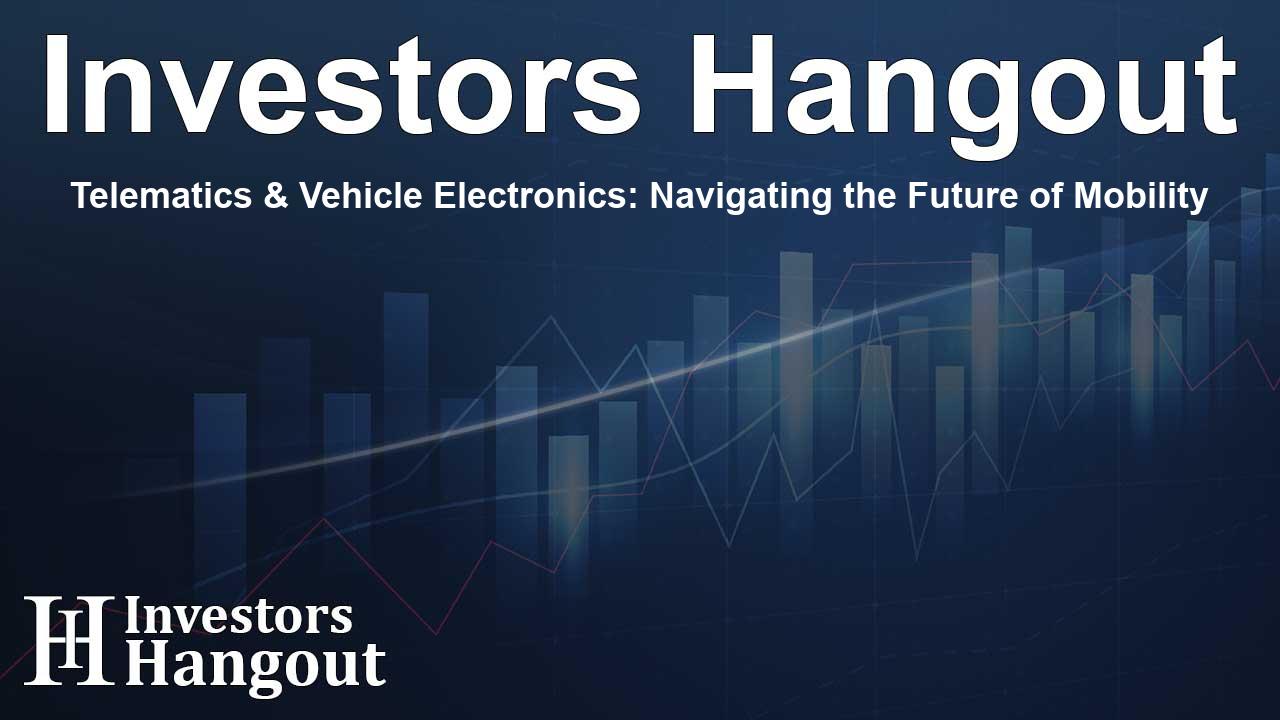Telematics & Vehicle Electronics: Navigating the Future of Mobility

The Next Digital Frontier: Telematics and Vehicle Electronics
As vehicles continue to evolve into intelligent, software-defined machines, the automotive industry is experiencing a significant transformation. The era of connectivity, automation, and data-driven intelligence is upon us. Modern vehicles now serve as dynamic digital platforms, equipped with advanced telematics and vehicle electronics. Key technologies within this ecosystem, including Vehicle-to-Infrastructure (V2I) telematics, real-time diagnostics, and over-the-air (OTA) software updates, are not mere advancements but are integral to the larger narrative of connected mobility.
Understanding the Evolution of Telematics
Telematics, which was once primarily focused on fleet tracking and navigation, has matured into a comprehensive layer of data infrastructure. Currently, the global telematics and vehicle electronics market is valued at approximately USD 63.4 billion. Forecasts indicate this market will grow to around USD 198 billion by 2034, showcasing a compound annual growth rate (CAGR) of 12.2%.
Data-Driven Maintenance
At the heart of this evolution is the capacity to extract, transmit, and process real-time data from vehicles. This approach is shifting the practice of maintenance from reactive to predictive, enabling automated interventions across connected environments. Leading companies such as Continental AG, Bosch, Harman International, ZF Friedrichshafen, and Aptiv are all working diligently to embed telematics control units (TCUs) and connectivity modules into new electric and internal combustion engine platforms, supporting software-driven services and enhancing safety functionalities.
The Transformative Power of V2I Telematics
Among the most groundbreaking innovations in vehicle technology is V2I telematics. This system enables vehicles to communicate with various road infrastructures such as traffic signals, toll booths, smart signage, and public safety systems. This direct communication allows for a real-time exchange of data, leading to enhanced traffic efficiency and safety.
Market Growth and Predictions
The global V2I telematics market is currently valued at approximately USD 2.6 billion, with projections indicating it will exceed USD 25.1 billion by 2034, representing a remarkable CAGR of 25.2%. Driving this growth are initiatives like smart city development, the rollout of 5G technology, and governmental mandates for intelligent transportation systems. Pioneers in the V2I landscape include Qualcomm, NXP Semiconductors, Savari, Cohda Wireless, and Panasonic, all of whom are creating the chips and software necessary for secure, low-latency V2I communications.
Advancing Real-Time Vehicle Diagnostics
Traditionally, vehicle diagnostics were limited to error codes accessed during service appointments. However, with real-time vehicle diagnostics, the monitoring of automotive health has undergone a revolution. By integrating sensors and telematics control units, critical vehicle parameters like engine temperature, oil levels, battery health, and brake systems are continuously monitored.
A Shift Towards Predictive Maintenance
Estimations show that the real-time vehicle diagnostics market will witness a rise from around USD 18.7 billion in 2024 to over USD 61.9 billion by 2034, a CAGR of 12.6%. This transformation helps extend vehicle lifespan, minimize downtime, improve safety, and save costs, particularly for fleet operators. Companies like Continental, Delphi Technologies, Bosch, and Valeo are leading this evolution by integrating AI-driven diagnostic modules capable of foreseeing potential failures.
Over-the-Air Software Updates: Embracing Change
Another significant advancement in automotive electronics is the implementation of OTA software updates. This capability allows original equipment manufacturers (OEMs) and Tier-1 suppliers to update vehicle software remotely without requiring a visit to service centers. As vehicles grow more software-centric, OTA updates are vital for delivering bug fixes, performance enhancements, feature updates, and cybersecurity improvements.
Growing Market and Adoption
The global market for OTA software updates stands at approximately USD 3.9 billion as of 2024 and is anticipated to reach USD 22.5 billion by 2034, demonstrating a strong CAGR of 19.1%. Pioneering this domain, companies like Tesla have been joined by others such as Ford, GM, BMW, Hyundai, and Volkswagen in adopting OTA capabilities. Technology providers such as Harman and Blackberry QNX are crucial for enabling secure OTA frameworks.
The Unified Ecosystem: Integrating V2I, Diagnostics, and OTA
V2I telematics, real-time diagnostics, and OTA updates form an interconnected ecosystem, enhancing each function's value. For instance, a vehicle communicating with its infrastructure can identify hazards like potholes, relay that information to the diagnostics system for potential suspension checks, and issue a software patch via OTA if necessary. This level of integration benefits fleet managers, allowing them to monitor vehicle health remotely and implement updates to optimize performance.
The Role of Edge Computing
As telematics architecture develops, the distinction between cloud computing and vehicle systems diminishes. Technologies like edge computing and AI, combined with 5G, will expedite this convergence. Companies such as Nvidia, Qualcomm, and Intel are making major strides, providing the necessary compute platforms for intelligent decision-making.
Key Players and Market Dynamics
Leading organizations shaping the market include some of the industry's giants such as Continental AG, Bosch, Harman International, and Aptiv. This dynamic landscape is pivotal for fostering innovation and collaboration in the sector.
Looking to the Future of Mobility
By 2034, the vision for the automotive industry indicates a future where vehicles will be seamlessly integrated into digital ecosystems, continuously engaging with infrastructure, self-diagnosing performance issues, and updating their software like smartphones. Telematics and vehicle electronics are pivotal to this transformation, creating a secure, adaptive driving experience that meet evolving demands.
Frequently Asked Questions
What is telematics in vehicles?
Telematics involves the integration of telecommunications and vehicle technology to monitor and manage vehicle performance in real-time.
How is V2I telematics changing urban mobility?
V2I telematics facilitates communication between vehicles and infrastructure, enhancing traffic efficiency and public safety.
What are the benefits of real-time vehicle diagnostics?
This technology allows for continuous health monitoring, reducing downtime, improving safety, and optimizing maintenance costs.
Why are OTA software updates important?
OTA updates enable manufacturers to remotely upgrade vehicle software, improving performance, adding features, and addressing security issues without service visits.
What impact does edge computing have on telematics?
Edge computing enhances data processing speed and efficiency in real-time applications, crucial for advancing telematics systems in vehicles.
About The Author
Contact Ryan Hughes privately here. Or send an email with ATTN: Ryan Hughes as the subject to contact@investorshangout.com.
About Investors Hangout
Investors Hangout is a leading online stock forum for financial discussion and learning, offering a wide range of free tools and resources. It draws in traders of all levels, who exchange market knowledge, investigate trading tactics, and keep an eye on industry developments in real time. Featuring financial articles, stock message boards, quotes, charts, company profiles, and live news updates. Through cooperative learning and a wealth of informational resources, it helps users from novices creating their first portfolios to experts honing their techniques. Join Investors Hangout today: https://investorshangout.com/
The content of this article is based on factual, publicly available information and does not represent legal, financial, or investment advice. Investors Hangout does not offer financial advice, and the author is not a licensed financial advisor. Consult a qualified advisor before making any financial or investment decisions based on this article. This article should not be considered advice to purchase, sell, or hold any securities or other investments. If any of the material provided here is inaccurate, please contact us for corrections.
